The seven feasts of the Lord were celebrated according to a seasonal harvest cycle, in a series of three festivals. This seasonal arrangement was not the most important aspect of Old Covenant worship, though. Israel’s feasts were a reminder that every individual lived in a special covenant relationship with the Lord. While only the men were required to appear at the temple three times a year to offer sacrifice, many made the journey with their families so everyone could participate in the sacrificial temple worship of the Lord’s feasts.
The covenant relationship between God and his chosen people of Israel was expressed in the themes of the feasts of the Lord, which celebrated the annual spiritual journey of God’s people, based on their ancestors’ journey to the Promised land so many generations before. This spiritual journey started with Passover, a remembrance of Israel’s exodus from Egypt, a reminder of their deliverance from sin and slavery to the values of the world. The Lord had consecrated his people as a first fruits offering to himself, so the worship cycle included a season of cleansing and individual consecration. Prayer and fasting characterized the seven weeks between the feasts of Firstfruits and the early summer feast of Pentecost, as the people re-dedicated themselves the Lord. The long hot summer wait between Pentecost and the fall festivals was rewarded by the autumn celebration of the olive and grape harvests.
This final festival started with the beginning of the secular new year on the Day of Trumpets, symbolizing a new beginning with God every year. This new start was characterized by a ten-day period of repentance, as everyone examined their conscience for wrongs committed against God and one’s neighbor in preparation for the coming forgiveness of the feast of Atonement. This short season of repentance prepared the people to receive the solemn blessings of the Day of Atonement, in which the sins of the people were forgiven and removed, and the temple was cleansed from sin. The people were reconciled to the Lord, and his Presence would dwell in the newly purified temple for another year. Once the serious business of atoning for sin was accomplished, the entire nation would celebrate the conclusion of another successful harvest year with the production of the new wine and oil. More importantly, everyone celebrated the fact that the Lord still dwelt on earth among his chosen people.
Tabernacles, the final feast, was celebrated with families building a small tent of willow branches. This was a reminder of the way their ancestors had lived during the journey through the wilderness on their way to the Promised Land. The word tabernacle means to dwell with someone. Just as the Lord tabernacled with his people in the desert, leading them by a cloud of smoke by day and a pillar of fire by night, he now led them in their daily lives, dwelling in the temple. Every year began a new spiritual journey in which the Lord’s people drew close to him through the celebration of the feasts, passing on the knowledge of God and the hope of the coming Redeemer to each new generation.
The following chart illustrates the timing of the feasts of the Lord, their required worship, and the theme of each feast that believers spiritually fulfill in their discipleship walk.



Copyright 2011

